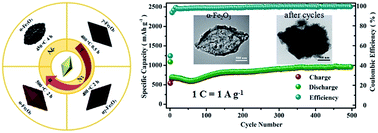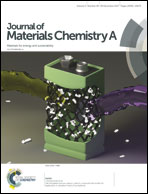Controlled pyrolysis of MIL-88A to Fe2O3@C nanocomposites with varied morphologies and phases for advanced lithium storage†
Abstract
Carbon-coated α-Fe2O3 hollow nanospindles and varied-phase Fe2O3@C (γ-Fe2O3@C, αγ-Fe2O3@C, and α-Fe2O3@C) nanobipyramids were prepared by controlling pyrolysis of MIL-88A nanobipyramids at different temperatures and time in air or in nitrogen. The corresponding pyrolysis stage in air, followed by a self-oxidation/reduction-like mechanism in nitrogen was proposed for the first time. When used as anodes for lithium-ion batteries (LIBs), the α-Fe2O3 hollow nanospindles with carbon-coated shells can not only facilitate the contact between the electrode and electrolyte and accommodate mechanical stress and volume change over multiple cycles but also enhance the electronic conductivity of the electrode materials. Benefiting from the unique carbon-coated hollow structure, the α-Fe2O3 nanospindle electrode delivered an over-theoretical capacity of about 1207 mA h g−1 after 200 cycles at 0.2C and reversible lithium storage capacity as high as 961.5 mA h g−1 after 500 cycles at 1C. Moreover, αγ-Fe2O3@C nanobipyramid electrode exhibits a superior specific capacity of 631.6 mA h g−1 at 1C after 150 cycles due to its derived unique nanoflake structure.



 Please wait while we load your content...
Please wait while we load your content...